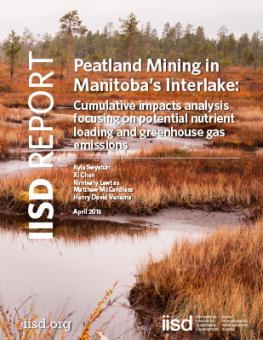
Peatland Mining in Manitoba’s Interlake: Cumulative impacts analysis focusing on potential nutrient loading and greenhouse gas emissions
Peat has been mined in Manitoba for over 70 years and currently represents approximately 13 per cent of Canada’s horticulture peat production.
Manitoba peat mining is potentially expanding in Manitoba’s Interlake, and this report quantifies the implications of this expansion for Lake Winnipeg nutrient loading and Manitoba’s greenhouse gas emissions. The technical analysis in this report will be incorporated into a cumulative environmental assessment on peat mining in Manitoba’s Interlake.
The report found that, with the expansion, nutrient leaching from active peat mines within Manitoba would not exceed 0.40 kilograms (kg) P ha-1 yr-1 and 15.00 kg N ha-1 yr-1. Total phosphorus and total nitrogen loads to Lake Winnipeg from current peat lease holdings in the Interlake would not exceed 5.1 tonnes P yr-1 and 191 tonnes N yr-1. Total phosphorus and total nitrogen loads to Lake Winnipeg from all current peat lease holdings within Manitoba would not exceed 12 tonnes P yr-1 and 449 tonnes N yr-1. These potential nutrient loads to Lake Winnipeg from peat mining operations represent a small proportion of the yearly loads of phosphorus and nitrogen to Lake Winnipeg.
Greenhouse gas emissions from land-use change due to active peat mines within Manitoba would not exceed 13.47 tonnes CO2e ha-1 yr-1. Total greenhouse gas emissions from current peat lease holdings in the Interlake would not exceed 0.17 million tonnes CO2e yr-1. Total greenhouse gas emissions from current peat lease holdings within Manitoba would not exceed 0.4 million tonnes CO2e yr-1.
Initial analysis can be found here.
Participating experts
You might also be interested in
Large Area Planning in the Nelson-Churchill River Basin (NCRB): Laying a foundation in northern Manitoba
This report explores two trends—the growing tendency towards large basin management and consideration of ecosystem services in decision making—for the northern portion of the Nelson-Churchill River Basin in Canada.
Large Area Planning in the Nelson-Churchill River Basin (NCRB): Laying a foundation in northern Manitoba (Summary)
This document summarizes a longer report that explores two trends—the growing tendency towards large basin management and consideration of ecosystem services in decision making—for the northern portion of the Nelson-Churchill River Basin in Canada.